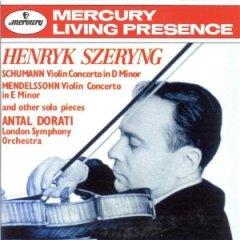Robert Schumann - Violin Concerto in D Minor (Szeryng) [1994]
Robert Schumann - Violin Concerto in D Minor (Szeryng) [1994]

01. I. In kraftigem, nicht zu schnellen Tempo
02. II. Langsam
03. III. Lebhaft docht nicht zu schnell
Henryk Szeryng – violin London Symphony Orchestra Antal Dorati - conductor
On September 21, 1853, Schumann entered into his daily record: "Have begun a piece for violin." On October 1, he noted that the "Concerto for Violin is finished," and by the third of the same month the piece was completely orchestrated. This record represents the last truly productive and happy time for the composer. He wished to have the Violin Concerto performed in Düsseldorf, but gave up his conducting post there, making such a concert nearly impossible. A concert tour and his production of music criticism made the planning of a performance a matter of secondary importance. Finally, the onset of his mental illness eliminated all hope of his programming the concerto, the saga of which continued long after the composer's death.
Shortly after completing the Violin Concerto, Schumann sent the piece to Joseph Joachim (1831-1907), asking if there were any passages that were "unplayable." Joachim, the concerto's intended recipient, was initially supportive of Schumann's efforts, but shortly after Schumann's death in 1856 he expressed his displeasure with "dreadful passages for the violin" to Clara Schumann. To this, Clara reacted by asking Joachim to re-write the last movement, which he never did. When Joachim finally did give a private performance of the concerto, in 1858 in Leipzig, Brahms found it so unsatisfactory that he elected not to include it in the Complete Edition of Schumann's Works, which he was then editing. Clara, Brahms, and Joachim decided the work should never be published.
Many years later, Joachim's son sold the manuscript of the concerto to the Prussian State Library, stipulating that the piece not be performed before the one-hundredth anniversary of Schumann's death. In 1937, Georg Schünemann found the manuscript, edited and published it despite the protests of Schumann's daughter, Eugenie. The concerto was first performed in Berlin by Georg Kulenkampff on November 26, 1937, and again on February 16, 1938, in London by Jelly D'Aranyi, Joachim's great-niece. Since its publication, critics' evaluations of the concerto have varied; most find the piece inferior.
In contrast to Schumann's other concertos, that for violin features a first movement built on the double exposition principal we find in Viennese Classical-era concertos. However, Schumann does not use the ritornello material as did his predecessors; he presents the secondary theme in a new key -- the relative major (F major) -- instead of reserving the modulation for the solo exposition as in most of the Viennese models. Thus, from the very beginning of the work we hear Schumann's "relaxed" approach to sonata form, in which tonal conflict is no longer of primary concern. When the solo part finally appears, it is with the first theme, without introductory flourishes and on the dominant. The developmental central section is not a "working out" (in a Beethovenian sense) but a transformation of thematic material, the repetitiveness of which Joachim found disturbing. The high point of the recapitulation is the return of the secondary subject in the solo part, which includes its own accompaniment of running sixteenth notes.
The brief second movement, in B flat major, features a beautiful theme that is similar to one Schumann (over a year later) thought was dictated to him in the asylum; Brahms would later write a set of variations on this theme. In the concerto, when Schumann recapitulates this theme, it is a third lower and in the minor mode, lending it greater poignancy. The Finale is a polonaise with a vivacious opening that drives to a bright close on D major. As a unifying device, Schumann accompanies the second subject with a variation of the opening measures of the second movement. ---John Palmer, Rovi
download: uploaded yandex 4shared mediafire solidfiles gett mega zalivalka filecloudio anonfiles oboom
Last Updated (Thursday, 01 May 2014 19:54)








